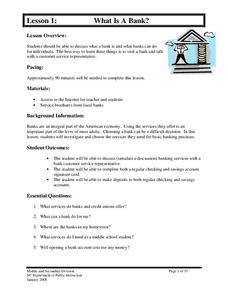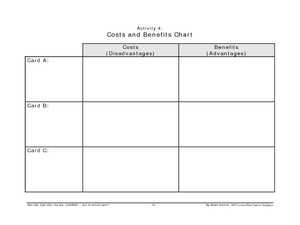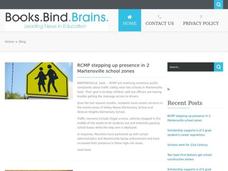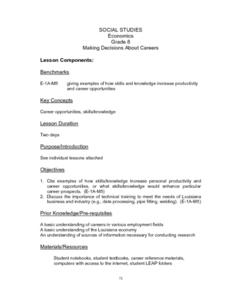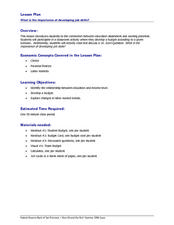Curated OER
Exchange Rate Problems
In this economics worksheet, students respond to 10 short answer and multiple choice questions about exchange rates throughout the world.
Curated OER
Supply and Demand
In this economics activity, learners read a selection on supply and demand and complete 2 multiple choice and 2 fill in the blank questions. As a bonus students draw a comic strip that shows supply vs. demand and answer a short answer...
Curated OER
Early Industrialization & Economic Growth (1)
In this online interactive American history worksheet, students respond to 10 multiple choice questions regarding American industrialization and economic growth . Students may check their answers immediately.
Curated OER
Master of Cooking
In this cooking worksheet, students complete multiple choice questions about cooking and baking. Students complete 6 questions total.
Curated OER
Early Industrialization & Economic Growth (2)
For this online interactive American history worksheet, learners answer 10 multiple choice questions regarding the American Industrial Revolution. High schoolers may submit their answers to be scored.
Curated OER
The Wants and Needs of Making a Difference
Students analyze a reading selection. In this wants and needs activity, students read a story to facilitate a discussion about wants and needs. Students discuss how communities help each other in difficult times.
Curated OER
You Can't Have it All
In this economic worksheet, 7th graders read about the ideas of choice as well as scarcity for producers and consumers. Students then complete three activities based on economic choices.
Curated OER
Federal Reserve Activity
Groups of four high schoolers take a look at the Federal Reserve, and study the impacts associated with the tweaks they make to our economic system. Each group is given a true economic scenario from our nation's past, and must compile a...
Federal Reserve Bank
What Do Financial Market Indicators Tell Us?
Explain the four categories of financial indicators (commodity prices, stock indexes, interest rates, and yield spreads), and help your class members understand how changes in this data can affect decisions regarding consumer spending,...
North Carolina Department of Public Instruction
What Is A Bank?
You're never too young to learn about banking and personal finance. Use a set of seven banking lessons to teach middle schoolers about checking and savings accounts, interest rates, loans and credit cards, and safety deposit boxes.
Council for Economic Education
Banks and Credit Unions (Part 1)
Imagine you have money you want to save ... where do you put it? Pupils investigate the similarities and differences of banks and credit unions as they determine where exactly to place their hard-earned money. Through a WebQuest,...
Curated OER
Charge Cards!
Young scholars identify and define the various types of credit cards and credit card offers. In this credit cards lesson, students identify the pros and cons of managing a credit card account. Young scholars locate information on the...
Curated OER
Money Management Intelligence
Students follow directions to help a client with his/her budget. After selecting their client, they download confidential data and listen to the challenge presented on the website. They adjust the budgets as needed. Then, they click play...
Curated OER
Quilting
Second graders make a quilt. In this cultural diversity lesson plan, 2nd graders review their knowledge of the Metis people. Students work in groups to create a class quilt that illustrates the lives of these people. Quilt themes include...
Curated OER
World Habitat Day
For this World Habitat Day lesson plan, students complete activities such as reading a passage, matching phrases, fill in the blanks, choose the correct word, multiple choice, unscramble the words, sequencing, unscramble the...
Curated OER
International Day of Democracy
In this International Day of Democracy worksheet, students complete activities such as reading a passage, phrase matching, fill in the blanks, correct words, multiple choice, spelling, sequencing, scrambled sentences, writing questions,...
Curated OER
Needs and Wants
First graders recognize the difference between needs and wants. In this treaty lesson, 1st graders chart their needs and wants to be used in making a treaty. Students negotiate what should be in the treaty based on the...
Curated OER
What Works and What Doesn't: The Potential and Limitations of Fiscal Policy
Twelfth graders study micro- and macro-economies. They examine theories about fiscal policy and the relationships between consumption and output, tax policy and government spending changes. They also consider how economic perspectives...
Curated OER
Economics: Actions of Government
Students examine the susceptibility of legislators to agricultural lobbyists to support subsidy programs. In small groups, they role-play as members of interest groups that might be affected by inflation.
Curated OER
The Economics of Voting
Students examine the voting behavior of people during a presidential election to determine costs and the benefits of voting and how this behavior is influenced by incentives.
Curated OER
Schools for Sale
Students differentiate between public and private goods. They analyze and evaluate various and positions on a public issue. They establish decision-making criteria. They develop a public policy based on a formal decision making model.
Curated OER
Wants and Needs
Here is an outstanding lesson on wants versus needs designed for 1st graders. Pupils listen to the book, Something Good which presents themes on wants, needs, choice, resources, and counting money. Pupils complete worksheets embedded in...
Curated OER
Making Decisions About Careers
Eighth graders engage in a lesson that is related to the concepts related to conducting research of the economy while focusing on career choices. They find information using a variety of different resources when including statistics of...
Curated OER
What is the Importance of Developing Job Skills?
Financial literacy is the way to teach! The class works in small groups to discover the relationship between education and income level. They use their math and problem-solving skills to complete two different activities. They work out a...









